ASUS ROG Maximus XII Hero Wi-Fi Review: The Tale of Two Motherboards
by Dr. Ian Cutress & Gavin Bonshor on June 11, 2020 11:45 AM EST- Posted in
- Motherboards
- Intel
- Asus
- ROG
- 5GBase-T
- Z490
- 10th Gen Core
- Comet Lake
CPU Performance, Short Form
For our motherboard reviews, we use our short form testing method. These tests usually focus on if a motherboard is using MultiCore Turbo (the feature used to have maximum turbo on at all times, giving a frequency advantage), or if there are slight gains to be had from tweaking the firmware. We put the memory settings at the CPU manufacturers suggested frequency, making it very easy to see which motherboards have MCT enabled by default.
For Z490 we are running using Windows 10 64-bit with the 1909 update.
Update: A Note About Z490 and Turbo
Normally we test our motherboards with out of the box settings. This means that the performance will get boosted based on whatever default algorithm each motherboard vendor implements with regards turbo time and boost power. Intel actively encourages this - the numbers it puts in for turbo time and turbo power are recommendations, rather than specifications, and Intel wants motherboard vendors to engineer their products to the turbo and power that each vendor deems acceptable for their product. As a result, a lot of motherboards will implement an aggressive turbo algorithm.
For this generation, ASUS has done something different. ASUS' enthusiast motherboards offer two different options on first boot: Intel recommendations, or ASUS recommendations. This means that there is a small performance delta between the two, especially for ASUS' high-end motherboards. ASUS has put this into the product based on customer feedback and how motherboard vendors have slowly drifted over the last decade to well beyond what Intel recommends.
For our testing methodology, we try to leave as much as we can on default, because this is part of what makes a motherboard different to any other, and the motherboard vendor has to decide how aggressive it must be. Also, for non-enthusiasts who daren't enter the BIOS, or understand even what turbo or a CPU or what memory channels are, they will just end up with the non-XMP default settings. It is unclear what such a person might select when presented with the ASUS default option.
At this point we have included the results from selecting Intel's recommendations on ASUS' boards. Based on feedback, we are in the process of including both sets of data in our Z490 reviews. We were planning to cover it in depth in our first ASUS Z490 review, but please bare with us while we update our results for this review. We will still cover it in depth in the ASUS review.
Rendering - Blender 2.7b: 3D Creation Suite
A high profile rendering tool, Blender is open-source allowing for massive amounts of configurability, and is used by a number of high-profile animation studios worldwide. The organization recently released a Blender benchmark package, a couple of weeks after we had narrowed our Blender test for our new suite, however their test can take over an hour. For our results, we run one of the sub-tests in that suite through the command line - a standard ‘bmw27’ scene in CPU only mode, and measure the time to complete the render.
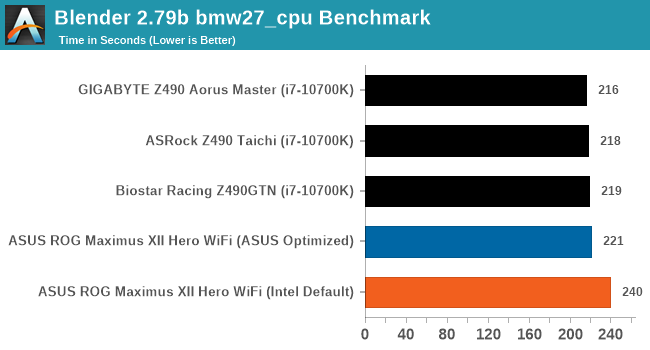
Rendering – POV-Ray 3.7.1: Ray Tracing
The Persistence of Vision Ray Tracer, or POV-Ray, is a freeware package for as the name suggests, ray tracing. It is a pure renderer, rather than modeling software, but the latest beta version contains a handy benchmark for stressing all processing threads on a platform. We have been using this test in motherboard reviews to test memory stability at various CPU speeds to good effect – if it passes the test, the IMC in the CPU is stable for a given CPU speed. As a CPU test, it runs for approximately 1-2 minutes on high-end platforms.
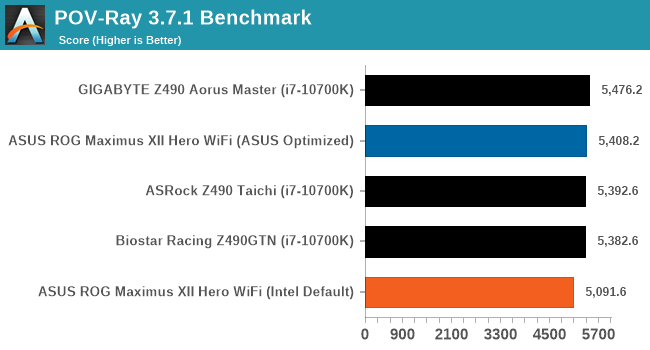
Rendering - Crysis CPU Render
One of the most oft used memes in computer gaming is ‘Can It Run Crysis?’. The original 2007 game, built in the Crytek engine by Crytek, was heralded as a computationally complex title for the hardware at the time and several years after, suggesting that a user needed graphics hardware from the future in order to run it. Fast forward over a decade, and the game runs fairly easily on modern GPUs, but we can also apply the same concept to pure CPU rendering – can the CPU render Crysis? Since 64 core processors entered the market, one can dream. We built a benchmark to see whether the hardware can.
For this test, we’re running Crysis’ own GPU benchmark, but in CPU render mode. This is a 2000 frame test, which we run over a series of resolutions from 800x600 up to 1920x1080. For simplicity, we provide the 1080p test here.
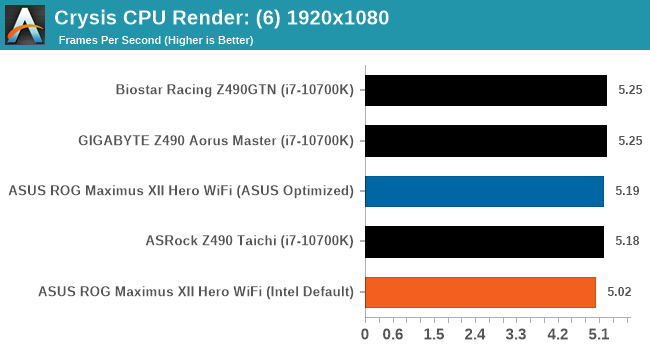
Point Calculations – 3D Movement Algorithm Test: link
3DPM is a self-penned benchmark, taking basic 3D movement algorithms used in Brownian Motion simulations and testing them for speed. High floating point performance, MHz, and IPC win in the single thread version, whereas the multithread version has to handle the threads and loves more cores. For a brief explanation of the platform agnostic coding behind this benchmark, see my forum post here.

NAMD ApoA1
One frequent request over the years has been for some form of molecular dynamics simulation. Molecular dynamics forms the basis of a lot of computational biology and chemistry when modeling specific molecules, enabling researchers to find low energy configurations or potential active binding sites, especially when looking at larger proteins. We’re using the NAMD software here, or Nanoscale Molecular Dynamics, often cited for its parallel efficiency. Unfortunately the version we’re using is limited to 64 threads on Windows, but we can still use it to analyze our processors. We’re simulating the ApoA1 protein for 10 minutes, and reporting back the ‘nanoseconds per day’ that our processor can simulate. Molecular dynamics is so complex that yes, you can spend a day simply calculating a nanosecond of molecular movement.
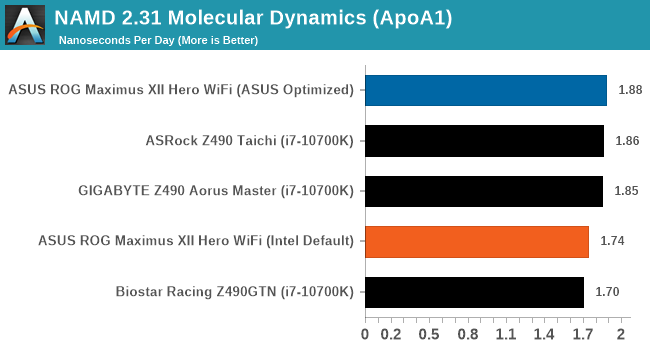
Application Load: GIMP 2.10.4
One of the most important aspects about user experience and workflow is how fast does a system respond. A good test of this is to see how long it takes for an application to load. Most applications these days, when on an SSD, load fairly instantly, however some office tools require asset pre-loading before being available. Most operating systems employ caching as well, so when certain software is loaded repeatedly (web browser, office tools), then can be initialized much quicker.
In our last suite, we tested how long it took to load a large PDF in Adobe Acrobat. Unfortunately this test was a nightmare to program for, and didn’t transfer over to Win10 RS3 easily. In the meantime we discovered an application that can automate this test, and we put it up against GIMP, a popular free open-source online photo editing tool, and the major alternative to Adobe Photoshop. We set it to load a large 50MB design template, and perform the load 10 times with 10 seconds in-between each. Due to caching, the first 3-5 results are often slower than the rest, and time to cache can be inconsistent, we take the average of the last five results to show CPU processing on cached loading.



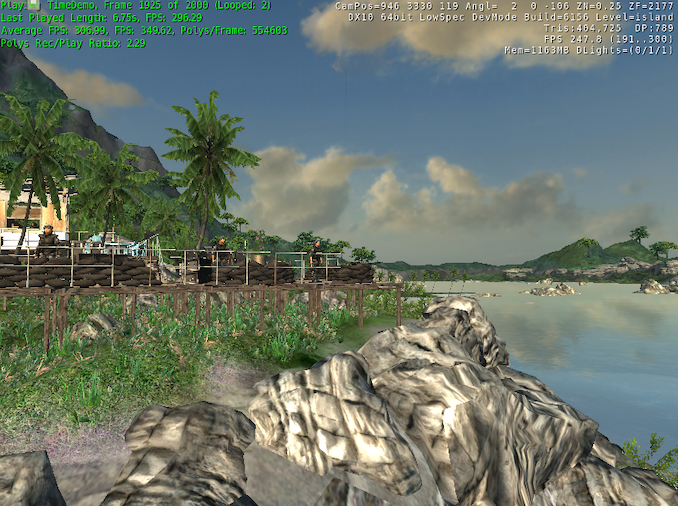








29 Comments
View All Comments
Devo2007 - Thursday, June 11, 2020 - link
“ The worry comes when the board is to be used by a non-technical user.”Something tells me a non-technical user would not be using this $400 motherboard anyways.
close - Thursday, June 11, 2020 - link
You'd be surprised how many people just want to buy the best/coolest just because. And once they have it they will also attempt to play a bit with it.GreenReaper - Friday, June 12, 2020 - link
Perhaps they will learn something by doing so.Tom Sunday - Wednesday, February 24, 2021 - link
My neighbor at his sweet age of 75 just bought himself a Mercedes-AMG GT Coupe. The folks at Palm Springs Mercedes love him. Harry drives about 300 miles per year as his fairway Thunderbird home is a 5-month snowbird retreat. The only passed get his GT will ever see are golf clubs if he elects to play another course and leave our gated community. Harry is also a very bad driver, very often gets lost when outside the gate, but a real nice guy otherwise.Harry knows nothing about computers and never will. But if so he would instantly be calling Digital Storm and drop $8000 on the very best they could possibly hobble together. But then many of us older retired guys here at the country club are actually like Harry. We of course here by choice would not really 'play a bit' with computers, as our minds and hopes are still tied to having a younger blond that can walk the walk and talk that talk. Maybe even cooks likes she walks? Try doing that with a motherboard.
kreimers - Friday, March 26, 2021 - link
Yep- spent almost $700 big ones on Crosshair Hero 8 which affords liquid cooling. Why? Could not get the Hero 4. Why? Supply from CCP was curtailed because of 1/2 trillion trade deficit with this communist crap of a country that launched the CCP virus so that mail-in fraudulent voting could occur. Now we have a fake president and other illegitimates who need to be removed from the White House- peacefully I hope. But if not, all bets are off. Regardless, silicon valley needs to be making most of this stuff here.n0t4h4x0r - Thursday, April 1, 2021 - link
You sound like old perverts. Maybe use that money for good and get a life? Your minds and hopes are tied to illusions that will never come true. You guys are the reason the country is falling apart. Not caring and only thinking about perverted crap. I've met many women online and then face to face obviously "wItH a MoThErBoArD" you pathetic old man. Sorry you missed out! Have fun playing your pathetic "game" of put a ball in a hole.Sorry you only had sex a handful of times(if that), but gtfo boomer.
Digital Storm. LOL.
Polaris198321 - Friday, June 12, 2020 - link
5g chipsets Wi-Fi 6 cat 7 Ethernet ports with special made chipset combining them all to boost internet speeds for desktops and laptops and smart tvs for 4k cable tv and cloud gaming at 144 hz at 1440p as the either net wire can also be used to power the device as well elimating the power cord as well if the computer cooling system using compressed air blown into it or solar transparent panels on glass panels for desktops. monitors and laptops are not for you like on the old Logitech solar powered wireless keyboard they once made back in the day i saw online and at costco...philehidiot - Thursday, June 11, 2020 - link
It has been a while since I had an Asus mobo with an optional stick on MOSFET cooling fan. It was back in the days of "MOAR PHASES!" because obviously 10000001 phase power is what you need on a mid range mobo.Peskarik - Thursday, June 11, 2020 - link
Thank you, I was waiting for this review!DanNeely - Thursday, June 11, 2020 - link
Where does the MOSFET fan attach to?